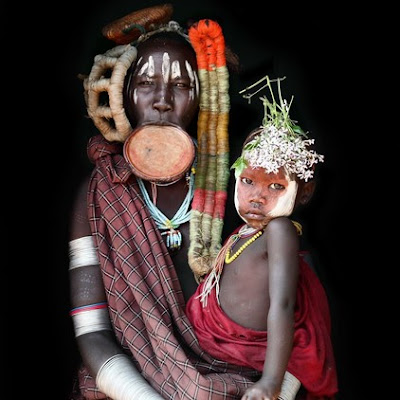Etiopía mantiene casi vírgenes, numerosas culturas ancestrales, que se manifiestan ahora casi en toda su plenitud, aunque se cierna sobre ellas, la amenaza de su desaparición a medio plazo.
Durante casi cinco décadas, he vivido muchas experiencias africanas, en muy diversos países y en todos ellos, he percibido un continente que se separa a pasos agigantados de la gran magia de su autenticidad.
No es que quiera que los africanos estén anclados en el pasado para disfrute de su exotismo. Antes al contrario, deseo que este maravilloso continente, tenga un desarrollo sostenible y que la paz y bienestar, llegue a todos su rincones.
Empresa difícil, en un mundo que primero le arrancó sus hijos hacia la esclavitud, y luego le extrae sus recursos naturales. Fanatismo, violencia, dictaduras, niños de la guerra, incultura..., son muchos los demonios que acechan este continente.
Mientras tanto, en el sur de Etiopía, hay un mundo de colores, de pueblos auténticos, que conviene conocer antes de que se pierda para siempre.
Me propongo ver, vivir y fotografiar ese mundo mágico y deseo hacerlo pronto. Está al alcance de un vuelo directo y un todo terreno, para el que busco 3 o 4 personas que tengan la curiosidad y el interés de vivir el pasado antes que se haga futuro.
Con un grupo reducido, sin intermediarios y gracias al contacto directo con una agencia local de solvencia, esta gran aventura humana es económicamente viable. No tengo interés económico; tan sólo compañía y abaratar el coste del viaje:
Una persona: 2220 euros
Dos personas: 1300 euros
Tres personas: 1110 euros
Cuatro personas: 890 euros
A este precio hay que incluir el coste del avión a Etiop
Recientemente, he vivido la pasión de encontrarme en un poblado masai dentro del cráter del Ngorongoro, en Tanzania. En este blog, hay un extenso testimonio fotográfico de aquella experiencia. No creo que la emoción que sentí, sea ni siquiera comparable a la que me espera, en un lugar apartado del turismo tal como lo concebimos.
Si te gustan los viajes alternativos y auténticos, tal vez quieras unirte a la hermosa aventura que deseo emprender. De ser así, contacta conmigo en midevago@gmail.com.
Ahora, te muestro unas fotografías extraídas por internet, de algunas de las tribus, que durante un viaje de 12 días, pretendo conocer.
Tribu Tsemay


Tribu Turmi
Tribu Mursi
Tribu Hamar

Tribu Karo

Tribu Erbore



Tribu Dorze
.jpg)
Cultural and Tribes Tour South Ethiopia Trip - 10 Days
Ethiopian Holidays Package ONE
Tour Code: TTT-B
No. of days:-09 nights/10 days
Destination:- south Omo valley
Mode of transportation: - Land transport
Day 01- Addis Ababa arrival and city tour
On arrival in Addis Ababa you will be met at the airport and transferred to the hotel. Addis was founded in 1886 by Menelik II, and situated at an elevation of around 2438m which makes third highest capital city in the world. Addis Ababa enjoys an excellent climate all year round, with an average temperature of 25°C. we will start our site-seeing by National museum which houses some of the country's historic treasures. The collection of fossils and bones of early hominids discovered in Ethiopia include the 3.5 million year old remains of 'Lucy', the oldest hominid every found. Proceed visiting to the two major highlights of the city, the Ethnographic Museum and the church of the Holy Trinity, Ethiopia's main cathedral and home to the remains of the last emperor, Haile Selassie.
Overnight in Ambassador Hotel (B,D)
Day 02- Addis Ababa and drive to Lake Langano
This day after our morning breakfast we will directly drive to Lake Langano and enjoy more of the Rift Valley landscape and the stunning views over the Lakes of Abijata and Shala. We have the possibility of visiting the Ostrich farm at Abijata Shala National Park. In the afternoon we will relax on the shore of lake Langano, side resort for our overnight.
Overnight at Sabana Beach Resort ( B,D)
Day 03- Langano to Arba Minch
After breakfast, drive to the famous lakeside town of Arba Minch. En route visit the villages of Gurage for their staple food of Kocho made from the false banana. We drive through one of the most colorful and scenic areas of Southern Ethiopia, a land that is inhabited by the Wolayita people, who were once nomads but are now farmers. Before arriving to the town of Arba Minch, a long section of the road offers magnificent views of lake Abaya, surrounded by mountains. The lake has volcanic origins and is almost pink in color.
Overnight at Paradise Lodge (B,D)
Day 04- Drive to Jinka via Konso and Kay Afer Market
Early morning drive to Konso where colorfully costumed dress, impressive terracing of the land and unusually engraved wooden statues used as grave markers can be seen. Differing from their neighbours, the Konso are pure agriculturists, famed for their use of the stone terraces that they utilise to such good effect in this dry and barren region of basalt hills. Originally from the east and speaking an east Cushitic language, the Konso live in settlements that are surrounded by stone walls. The age of each town is classified by a generation pole and each family lives in compounds that are accessible only through gateways that require the visitor to enter on all fours thereby rendering any potential attackers vulnerable.
Keep driving to Key Afer for the colourful Thursday market where we should see and photographed the Ari, Bena, Hamer and Tsemay people. The Bena and Hamer women usually favour red clay braids in their hair, shiny with butter and perfumed with incense. The long beaded skirts of the Tsemay have a stick incorporated in the back to denote a married woman and the men have elaborately plaited hairstyles decorated with feathers and colourful beads.
After visiting the market we drive on to Jinka, often called the gateway to the Omo Valley.
Overnight at Oret (B,D)
Day 05- Visit the Mursi Tribes in Mago National Park
Early morning drive to Mago National Park, from here, visit the Mursi highlands where the most illustrious of Ethiopia's unique tribes lives. The Mursi are known all over the world, for their decorative lip plates that adorn the lower lips of the Mursi women. The plates stretch the lower lip beyond imagination and the women's beauty , pride and desirability is determined in direct proportion to the size of the plate. The Mursi men and women may appear gracious but the Mursi warriors are not to be sneezed at. On their arms are deep crescent incisions that represent each enemy they have killed in battle. The men are also famous for their hairstyle. The various cultural aspects of the tribe will be explained and you will be able to take their photographs but not for free. Back to Jinka for your lunch and afternoon go to the Ari Village near by the town of Jinka for experiencing and learning the culture of Ari tribe and explore how they make their traditional homemade alcoholic drinks.
Overnight at Oret (B,D)
Day 06- Drive to Turmi and visit the Hamer Tribes ( Dimmeka Market )
This day, we will continue driving through the Omo Valley region to Turmi via Dimeka. The Hamer tribe is one of the largest groups in the Valley. The Hamer cultivate millet, vegetables,
tobacco and cotton as well as raising cattle and goats. They are known for the fine pottery they produce as well as their remarkable hairstyling. Most dramatic of all are the clay hair buns with ostrich feathers that the men don when they have killed a fierce animal. The Hamer women are simply stunning. The women wear beaded necklaces and iron coils around their arms and decorate their skin with cowry shells. These decorations indicate the wealth and prestige of a woman’s husband.
Overnight at Buska Lodge.(B,D)
Day 07 – Turmi - Murulle - Turmi
This day morning, we continue through the savannah along tracks that are barely visible, passing through a vast meadowland with shrubs and
umbellifers ('umbrella' acacia trees) for an excursion to the Murulle area. We arrive at Korcho village with beautiful views over the Omo River to see the Karo ethnic group, experts in body painting, using clay and locally available vegetable pigments to paint fantastic patterns on each other's faces, chests, arms and legs. These designs have no special symbolic significance, but are created purely for fun and aesthetic effect, each artist vying to out-do their fellow artists. Karo men also sculpt and shave their hair into extravagant shapes, with special ochre "caps" of hair usually containing several ostrich feathers. En route have a picnic lunch. We then drive back to the village of Turmi.
Overnight at Buska Lodge.(B,D)
Day 08 - Drive back to ArbaMinch
This day we will drive to Yabello visiting the Erbore people en route. Then we will proceed to the New-York; a bizarre landscape of sand panicles formed by wind and rain (erosion). After lunch stop at Konso, continue Arba Minch for our overnight stops.
Overnight at Paradise Lodge (B,D)
Day 09 – Visit the Chencha village and boat trip on Lake Chamo
Morning drive 40kms northwest of Arba Minch to Guge Mountains to visit the Dorze and Chencha villages. Once warriors, the Dorze have now turned to farming and weaving to earn a living. They speak an Omotic tongue and the Dorze name is synonymous with the best woven cotton cloth. The "elephant huts" of the Dorze are unique and worth seeing. Also, the Dorze beehive-shaped houses are constructed entirely of organic material and has its own small garden surrounded by beds of spices, cabbage and tobacco. Some of Ethiopia’s best woven cottons come from Chencha, which is located 8 km northwest of Dorze Village. Men weave and women spin.
Afternoon a boat trip on clear blue waters of Lake Chamo to see the crocodiles, hippos & aquatic bird species. The northern shores of Lake Chamo are famous for its large crocodiles, which can be seen in great numbers lounging in the heat. The lake is about 32km long and provides a lush wetland habitat for many species of flora and fauna.
Overnight at Paradise Lodge (B,D)
Day 10 –Drive back to Addis Ababa and Departure
We will drive back to Addis on the way we will visit the Tiya Stelea and Adadi Maryam Simi Rock Church. We will arrive in Addis Ababa in early afternoon and you might be interested for the last minute souvenir shopping at the markets. In the evening, we will go out to one of the best cultural restaurant for the Farewell Dinner at traditional restaurant with live traditional dances program. Then, transfer to the airport for your departure to Home. Tour End! (B, D)
unforgettable memory of Ethiopia Taitu Tour and Travel.
Services Inclusions:
➢ Meet and greetings at the Airport and assistance for Hotel transfer.
➢ Hotel Accommodations based on Single Room..
➢ Meals based on half board ( Breakfast, And Dinner) through out the trip each day.
➢ Comprehensive touring program including entrance fees where applicable according to the itinerary.
➢ Local guides fees.
➢ Professional Guide(Spanish speaking).
➢ Transfers and all ground transportations based on Best 4WD cars fuel and driver expense.as per the itinerary with all fuel expenses.
➢ Additional activities for experiencing the real culture of Ethiopia: Coffee ceremony and Honey wine drink.
➢ Boat trip on the lake Cahmo in the South Omo Valley.
➢ All necessary Government taxes.
Services Exclusions
➢ International Flight
➢ Porterage fees.
➢ Travel Insurance.
➢ Video filming and photography fees.
➢ Personal nature expenses, alcoholic drinks, laundry expenses, telephone calls, tips for the tour staffs etc...
➢ Any other expenses except those listed on the inclusion parts













No hay comentarios:
Publicar un comentario